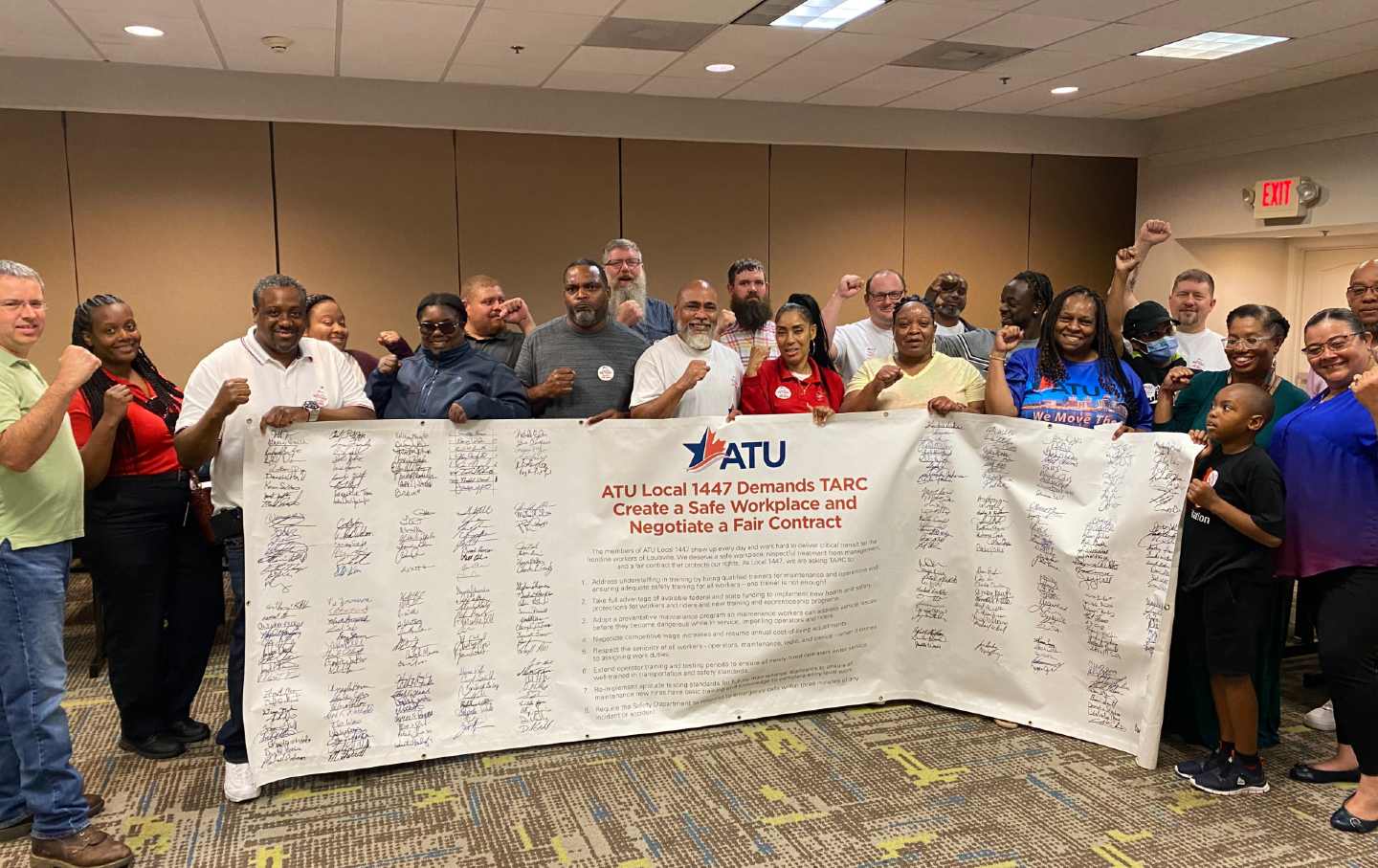Prove You're Ready to Beat the Boss With Structure Tests
November 14, 2024
In the typical workplace, bosses hold all of the power. They set the rules, decide on wages and benefits, and often pit workers against each other to maintain control. Employees, on the other hand, feel powerless and isolated, making it difficult to demand improvements or challenge unfair practices.
But things don't have to stay this way. When workers come together, they can shift the balance of power and create meaningful change. This is where structure tests come in- they're a tool for workers to flex their collective strength, demonstrate solidarity, and show bosses that they mean business.
In this blog post, we'll explain what structure tests are, why they're crucial for building worker power, and how you can plan and implement your own escalating campaign of structure tests. By the end, you'll have the know-how to prove to bosses and coworkers alike that you're serious about winning real change.
Let's dive in and learn how structure tests can help you prove you're ready to beat the boss.
Understanding Structure Tests
So what exactly are structure tests? In simple terms, they're collective actions that workers take to demonstrate their unity, commitment, and growing willingness to fight for better conditions.
Think of them as a series of rehearsals or practice rounds before the main event– like a union certification election or collective bargaining negotiation. Each test helps build worker solidarity, shows bosses that you're serious about making changes, and tests your ability to organize and take action together.
Now that we've got a handle on what structure tests are, let's look at some examples to illustrate how they work in practice. We'll start with smaller, low-risk actions and build up to more ambitious efforts, showing the escalating nature of effective structure test campaigns.
Example Escalating Campaign of Structure Tests
To help you visualize how structure tests can progress over time, let's walk through some examples ranging from simple meetings to full-blown strikes. Remember that each test should build upon the last, escalating in size, scope, and risk as workers gain confidence and momentum. While some of these may not be applicable to your specific situation, they should at least get you thinking about what's possible.
You'll notice that we recommend a minimum support percentage for each structure test. That's the minimum fraction of supporters among your coworkers we think you'll need to successfully pull off each structure test. However, these are just recommendations- only you can decide if you're ready to take each of these on.
-
Hold a meeting or social event
- Goal: Get coworkers together, break the ice, and start building relationships.
- Minimum support: 1%
- Example: Organize an after-work drinks gathering or potluck at someone's home. The purpose is to foster camaraderie and create opportunities for conversations about workplace issues.
-
Start signing union authorization cards
- Goal: Get a signed commitment from coworkers who want to be represented by your union.
- Minimum support: 10%
- Example: Create union authorization cards and have your network of organic leaders ask their colleages to sign them to show their support. Here's a template that fits on ordinary 3x5 index cards (view it or customize your own). Don't want to deal with physical cards or the hassle of data entry? The Organize app makes it easy to sign and collect digital union cards.
-
Sign a majority petition
- Goal: Demonstrate majority support for your union among coworkers.
- Minimum support: 51%
- Example: Create a petition demanding that management recognize your union. Use your network of organic leaders to quickly gather signatures from each of their colleages. Aim to gather all of the signatures in just 2 to 3 days to prove you can mobilize quickly.
-
Wear pro-union gear on specific days
- Goal: Visibly show your growing level of support among coworkers.
- Minimum support: 60%
- Example: Organize "Sticker Up" or "Red Shirt Friday" events where workers wear union-themed stickers, buttons, pins, or clothing to work. This helps identify supporters, encourages conversations about your union, and signals your growing collective power to management.
-
Hold a pro-union rally or march
- Goal: Publicly demonstrate worker unity to the broader community.
- Minimum support: 75%
- Example: Organize a rally outside your workplace during a shift change, inviting coworkers and community supporters. Create picket signs together and practice marching in solidarity.
-
Organize an overtime boycott
- Goal: Address chronic understaffing issues by refusing to work unplanned or unwanted overtime.
- Minimum support: 80%
- Example: If bosses consistently rely on workers volunteering for overtime to cover short-staffed shifts, coordinate a boycott where everyone refuses extra hours. This can highlight the problem and put pressure on management to hire more staff or rebalance workloads fairly.
-
Hold a mock strike vote
- Goal: Practice the democratic process of voting for collective action and build enthusiasm for a potential strike.
- Minimum support: 85%
- Example: Organize a secret ballot vote among coworkers, asking them if they'd be willing to strike in support of specific demands. This helps identify your supermajority, builds momentum, and prepares workers for the real thing.
-
Go on strike
- Goal: Win concrete improvements by withholding your labor collectively until bosses agree to your demands.
- Minimum support: 90%
- Example: A strike is the most powerful weapon in workers' arsenals, bringing production to a halt and forcing bosses to the negotiating table. However, it's also the riskiest structure test, so don't try this one until you've used many of the other structure tests above to prove that you're ready.
As you can see, each structure test builds upon the last, gradually increasing the stakes and demonstrating growing worker unity, commitment, and willingness to fight for change. Now let's discuss why a having supermajority is so important for winning meaningful improvements in your workplace.
Why You Need a Supermajority to Beat the Boss
Were you surprised to see us recommend 90% as the minimum support needed to successfully strike? It's tempting to think that a simple majority is enough to win a strike, but let's challenge this assumption and explore why having a supermajority—a solid 90% of your coworkers on board—is crucial to beating the boss.
Harness Your Coworkers' Full Potential
A strike is not just about individual workers walking off the job- it's about collective power. When you strike together as a supermajority, you send a clear message to management that they cannot replace or ignore you without significant consequences.
Imagine trying to strike with only 51% support. In such a scenario, there's:
- A Divided Workforce: Your workplace would be split down the middle, with coworkers eyeing each other suspiciously, wondering who's in and who's out.
- Easier Replacement: The 49% could keep production partially running, giving management time to find replacements for those on strike.
- Morale Issues: Strikers might feel isolated and demoralized, while those not striking could feel guilty or conflicted.
None of these scenarios bode well for a successful strike. In contrast, a 90% supermajority ensures that there's:
- A United Front: Your workplace stands united, sending a strong message to management.
- Tougher Replacement: With so many workers downing tools, it's much harder for bosses to find replacements or keep production running at all.
- High Morale: Strikers feel empowered and supported by their colleagues, while non-strikers might even have a change-of-heart and join the picket line.
Seriously Improve Your Bargaining Power
A supermajority doesn't just make your strike more effective, it also massively enhances your bargaining power. Here's why:
With a solid 90% behind you, management knows that they can't simply wait out the strikers or find easy replacements. They understand that they're facing a united front ready to dig in for the long haul if necessary. This reality shifts the balance of power in negotiations, making management more likely to come to the table with serious offers.
In contrast, if you only have 51% support, management might gamble on wearing down the strikers or replacing them entirely, preventing meaningful negotiations.
To sum up, aiming for a 90% supermajority is about winning- not just the strike, but the fight for a better workplace.
Conclusion
Structure tests are an essential tool in building worker power and proving that you're serious about achieving positive change. By demonstrating your increasing unity, commitment, and collective action through structure tests, you'll not only strengthen your position but also develop a solid foundation for winning concrete improvements.
Remember, each step along the way serves as practice for more significant actions like an overtime boycott or even a strike. As you progress through these tests, you'll gain valuable experience in organizing, acting collectively, and demonstrating worker solidarity– skills that will be invaluable in securing victory against bosses who might otherwise underestimate your resolve.
So embrace structure tests as opportunities to grow, learn, and demonstrate your collective power. With each successful test, you'll edge closer to beating the boss and creating a better workplace for all.
Want to form your own labor union? Download Organize free to get started today.

